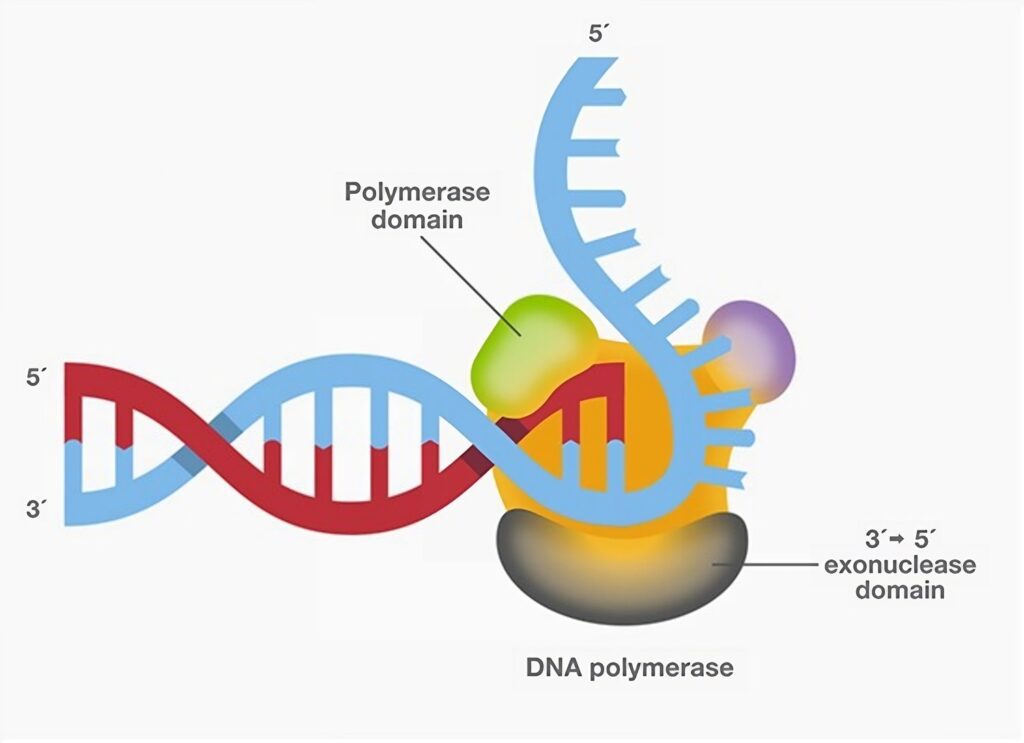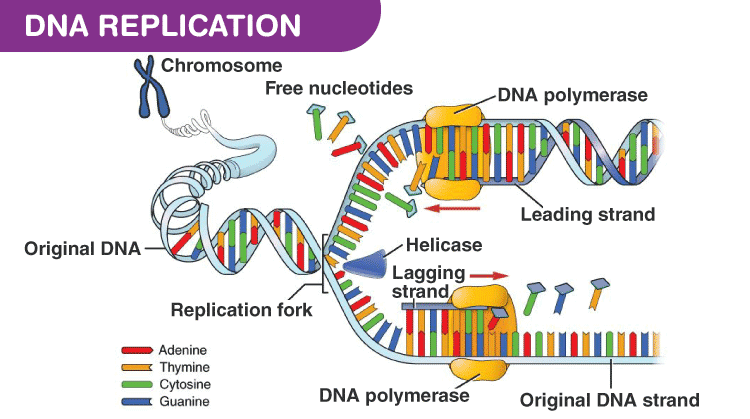Introduction
DNA polymerases are essential enzymes found in all living organisms. These enzymes help create copies of DNA molecules by adding new nucleotides (the building blocks of DNA) during the process of DNA replication. Without DNA polymerases, cells would not be able to divide and pass on genetic information to new cells. Although both eukaryotic (complex cells with a nucleus, like in humans, animals, and plants) and prokaryotic (simple cells without a nucleus, like in bacteria) organisms rely on DNA polymerases, the enzymes in these two types of organisms have several differences.
In this document, we’ll explore in a simple, humanized, and easy-to-understand manner the roles, types, structures, and differences between eukaryotic and prokaryotic DNA polymerases. We’ll also talk about how they work, where they are found in the cell, and why they matter in science and medicine.
Table of Contents
What Are DNA Polymerases?
DNA polymerases are enzymes that make new DNA strands by using existing DNA as a template. When a cell is about to divide, it needs to make an exact copy of its DNA so that both new cells get the same genetic information. DNA polymerase “reads” one strand of DNA and builds a matching strand by adding the right nucleotides (A, T, G, and C).

DNA polymerase does not work alone. It needs other helper proteins, such as primers (short RNA pieces), helicase (to unwind DNA), and ligase (to seal gaps), to complete DNA replication smoothly.
Prokaryotic DNA Polymerases
Prokaryotes are organisms like bacteria. Their DNA is found in a single, circular chromosome floating in the cytoplasm. Prokaryotic DNA polymerases are simpler and fewer in number compared to eukaryotic polymerases.

Major Prokaryotic DNA Polymerases
- DNA Polymerase I
- Removes RNA primers and replaces them with DNA.
- Helps in repairing damaged DNA.
- Has proofreading ability to fix mistakes.
- DNA Polymerase II
- Mainly involved in DNA repair.
- Can help restart DNA replication if it stops due to damage.
- DNA Polymerase III
- The main enzyme for DNA replication.
- Builds new DNA strands quickly and with high accuracy.
- Has a proofreading function to correct errors.
- DNA Polymerase IV and V
- Involved in special types of DNA repair.
- Can work even when DNA is damaged, but may be more error-prone.
Features of Prokaryotic DNA Polymerases
- Fewer types (mainly I, II, III, IV, and V).
- Found in the cytoplasm.
- Work faster due to simpler cell structure.
- Some are very accurate (especially DNA Polymerase III).
- Others are more error-prone but useful in stress conditions.
Eukaryotic DNA Polymerases
Eukaryotes include humans, animals, plants, fungi, and other complex organisms. Their DNA is found inside the nucleus, stored in multiple chromosomes. Eukaryotic DNA replication is more complex and involves many more enzymes.

Major Eukaryotic DNA Polymerases
- DNA Polymerase α (Alpha)
- Starts the DNA replication process.
- Works with primase to make RNA primers and a short DNA strand.
- DNA Polymerase δ (Delta)
- Main polymerase for the lagging strand.
- Extends the DNA strand after Polymerase α begins it.
- DNA Polymerase ε (Epsilon)
- Main polymerase for the leading strand.
- Works fast and with high accuracy.
- DNA Polymerase γ (Gamma)
- Replicates mitochondrial DNA (DNA found in the mitochondria).
- DNA Polymerase β (Beta)
- Involved in repairing damaged DNA.
- Other Specialized Polymerases
- Help with repair, bypass of damaged DNA, or other functions.
Features of Eukaryotic DNA Polymerases
- Many types, each with a specialized role.
- Found mainly inside the nucleus, except for Polymerase γ (mitochondria).
- Work slower but are more regulated.
- Require more helper proteins.
- Are more accurate due to complex proofreading mechanisms.
Key Differences Between Eukaryotic and Prokaryotic DNA Polymerases
| Feature | Prokaryotic DNA Polymerases | Eukaryotic DNA Polymerases |
|---|---|---|
| Number of types | Fewer (mainly 5 types) | Many (more than 14 types) |
| Main polymerase | DNA Pol III | DNA Pol δ and ε |
| Proofreading | Yes (Pol I and III) | Yes (Pol δ and ε) |
| Speed | Faster | Slower |
| Location | Cytoplasm | Nucleus and mitochondria |
| Primer removal | Done by Pol I | Done by RNase H and FEN1 enzyme |
| Start of replication | Pol III and primase | Pol α and primase |
| Mitochondrial replication | Not separate | Done by DNA Pol γ |
Similarities Between Eukaryotic and Prokaryotic DNA Polymerases
- Both require a template strand and a primer to start.
- Both build new DNA in the 5’3 direction.
- Both add nucleotides one at a time using complementary base pairing.
- Both help in DNA repair and replication.
- Both have proofreading ability (at least the main ones).
Applications in Science and Medicine
Understanding DNA polymerases helps scientists:
- Develop antibiotics (targeting bacterial DNA polymerases).
- Make cancer drugs that block fast-dividing cells (targeting human DNA replication).
- Use DNA polymerases in PCR (Polymerase Chain Reaction) to amplify DNA.
- Study genetic diseases caused by faulty polymerases.
- Improve DNA sequencing and gene editing technologies.
Conclusion
DNA polymerases are key players in life’s most important process — copying DNA. Although both eukaryotic and prokaryotic organisms rely on these enzymes, the way they work and their complexity are different. Prokaryotic DNA polymerases are simpler and faster, while eukaryotic ones are more advanced and accurate.
Understanding these differences is not just important for biology students and researchers, but also for anyone interested in how life functions at the molecular level. With ongoing research, scientists continue to discover new ways these enzymes can be used in medicine, agriculture, biotechnology, and beyond.
Three Key Summary
- DNA polymerases are enzymes that copy DNA during cell division, essential for life.
- Prokaryotic polymerases are fewer and simpler, while eukaryotic ones are more complex and specialized.
- Knowing how these enzymes work helps in medical treatments, research, and biotechnology.
FREQUENTLY ASKED QUESTIONS
What is the main function of DNA polymerase?
DNA polymerase copies DNA so that cells can divide and pass on genetic information.
How is eukaryotic DNA polymerase different from prokaryotic?
Eukaryotic DNA polymerases are more numerous, complex, and work inside the nucleus, while prokaryotic ones are simpler and work in the cytoplasm.
Which DNA polymerase is used in PCR?
Taq polymerase, a type of prokaryotic polymerase from Thermus aquaticus, is used in PCR because it can withstand high temperatures.
Related Articles




